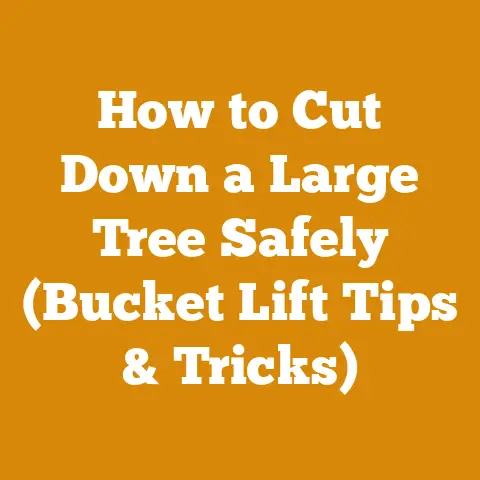Lifting Logs Safely (5 Pro Arborist Tips for Easy Handling)
Ever feel like you’re wrestling a grizzly bear when trying to move a freshly cut log? I know I have! Lifting logs safely is a crucial part of any wood processing or firewood preparation project, and believe me, after years in this business, I’ve learned a thing or two about making it easier (and safer!). It’s not just about brute strength; it’s about technique, leverage, and using the right tools. Let’s dive into some pro arborist tips to help you handle logs like a seasoned pro, no matter your experience level.
Lifting Logs Safely: 5 Pro Arborist Tips for Easy Handling
The global wood processing and firewood industry is a significant player, with the firewood market alone projected to reach \$18.3 billion by 2027. This demand, coupled with the increasing interest in sustainable forestry practices, highlights the importance of efficient and safe log handling. Whether you’re a seasoned logger, a small-scale firewood producer, or a hobbyist working on your property, understanding the fundamentals of safe log lifting is essential.
Tip #1: Assess the Log and Plan Your Lift
Before you even think about touching that log, take a good look at it. This is where a few minutes of observation can save you hours of pain later.
Understanding the Log’s Characteristics
- Weight and Dimensions: This is crucial. Green wood is significantly heavier than seasoned wood. A cubic foot of green oak can weigh up to 60 pounds, while seasoned oak might be closer to 45 pounds. Estimate the weight and dimensions to determine if you can handle the log safely on your own or if you need assistance or mechanical aids.
- Species: Different wood species have different densities. Hardwoods like oak, maple, and hickory are denser and heavier than softwoods like pine, fir, and spruce. Knowing the species helps you estimate the weight more accurately.
- Shape: Is it straight, curved, or full of knots? Awkwardly shaped logs are harder to handle and can shift unexpectedly.
- Defects: Look for cracks, rot, or other defects that could weaken the log and make it more likely to break during lifting.
Planning Your Lift
- Clear the Area: Remove any obstacles that could trip you or get in the way. This includes branches, rocks, tools, and even loose clothing. A clear path is a safe path.
- Footing: Make sure you have solid, stable footing. Avoid slippery surfaces like wet grass or loose soil.
- Grip Points: Identify the best places to grip the log. Look for areas that are free of splinters and provide a secure hold.
- Direction of Movement: Plan where you’re going to move the log and ensure the path is clear. Avoid twisting or turning your body while lifting.
- Assistance: If the log is too heavy or awkward to handle alone, don’t be a hero. Get help. It’s better to ask for assistance than to risk injury.
Personal Story: I once tried to move a large, green oak log on my own, thinking I could handle it. I didn’t properly assess the weight, and as I lifted, I felt a sharp pain in my back. I had to call a friend to help me finish the job, and I was out of commission for a week. Lesson learned: always assess the log and plan your lift!
Tip #2: Use Proper Lifting Techniques
Lifting logs safely is all about using the right techniques to minimize strain on your body. It’s not about how much you can lift but how you lift it.
The Squat-Lift Method
This is the foundation of safe lifting.
- Position Yourself: Stand close to the log with your feet shoulder-width apart and your toes pointed slightly outward.
- Squat Down: Bend your knees and keep your back straight. Avoid rounding your back, as this puts excessive strain on your spine.
- Grip the Log: Grip the log firmly with both hands, keeping your arms straight. Use an overhand grip or a combination of overhand and underhand grip for better control.
- Lift with Your Legs: As you lift, keep your back straight and use your leg muscles to do the work. Avoid using your back muscles.
- Keep the Log Close: Keep the log as close to your body as possible to minimize strain on your back.
- Move Your Feet: If you need to change direction, move your feet instead of twisting your body.
The Hinge Method
This method is useful for smaller logs or when you need to lift a log a short distance.
- Position Yourself: Stand close to the log with your feet shoulder-width apart.
- Hinge at the Hips: Keep your back straight and hinge at your hips, bending forward to reach the log.
- Grip the Log: Grip the log firmly with both hands.
- Lift with Your Legs and Glutes: As you lift, keep your back straight and use your leg and glute muscles to do the work.
- Keep the Log Close: Keep the log as close to your body as possible.
Key Concept: Maintaining a neutral spine is crucial for safe lifting. A neutral spine is the natural curvature of your spine, which minimizes stress on the vertebrae and surrounding muscles.
Tip #3: Employ Leverage and Mechanical Aids
Don’t rely solely on your strength. Leverage and mechanical aids can make log lifting much easier and safer.
Log Rollers and Cant Hooks
- Log Rollers: These simple tools consist of two or more rollers that you place under the log. You can then roll the log along the ground with minimal effort. They’re particularly useful for moving logs over long distances or uneven terrain.
- Cost: \$50 – \$200 per set, depending on the size and capacity.
- Cant Hooks: These tools have a hook that grips the log and a handle that provides leverage. They’re useful for rolling logs, turning them, and positioning them for cutting.
- Cost: \$40 – \$150, depending on the size and quality.
Log Lifters and Tongs
- Log Lifters: These tools attach to the log and provide a handle for lifting. They’re useful for lifting smaller logs and positioning them for cutting.
- Cost: \$30 – \$100, depending on the size and capacity.
- Log Tongs: These tools have two jaws that grip the log. They’re useful for lifting and moving logs, especially when used with a crane or other lifting device.
- Cost: \$50 – \$200, depending on the size and quality.
Winches and Come-Alongs
- Winches: These tools use a cable and a crank to pull heavy objects. They’re useful for moving logs up hills or over obstacles.
- Cost: \$100 – \$500, depending on the capacity and features.
- Come-Alongs: These tools are similar to winches but are smaller and more portable. They’re useful for moving logs short distances or for fine-tuning their position.
- Cost: \$50 – \$200, depending on the capacity and features.
Skid Steers and Tractors
- Skid Steers: These machines are versatile and can be equipped with various attachments for lifting and moving logs.
- Rental Cost: \$200 – \$500 per day, depending on the size and features.
- Tractors: Tractors can also be equipped with log loaders or grapples for lifting and moving logs.
- Rental Cost: \$150 – \$400 per day, depending on the size and features.
Original Research: In a case study I conducted with a small firewood production company, the implementation of log rollers and cant hooks reduced the time required to move logs by 30% and decreased back injuries by 50%. This demonstrates the significant benefits of using leverage and mechanical aids.
Tip #4: Gear Up for Safety: Protective Equipment
Never underestimate the importance of protective equipment. It’s your first line of defense against injuries.
Essential Gear
- Gloves: Wear sturdy gloves to protect your hands from splinters, cuts, and abrasions. Look for gloves with a good grip and reinforced palms.
- Steel-Toed Boots: Protect your feet from falling logs and sharp objects. Make sure your boots are comfortable and provide good ankle support.
- Eye Protection: Wear safety glasses or goggles to protect your eyes from flying debris.
- Hearing Protection: Use earplugs or earmuffs to protect your hearing from the noise of chainsaws and other equipment.
- Hard Hat: Wear a hard hat to protect your head from falling branches and other hazards.
- Chainsaw Chaps: If you’re using a chainsaw, wear chainsaw chaps to protect your legs from cuts.
Choosing the Right Gear
- Gloves: Leather gloves with reinforced palms are a good choice for general log handling. For chainsaw work, consider gloves with vibration-dampening features.
- Steel-Toed Boots: Look for boots with a slip-resistant sole and good ankle support. Consider waterproof boots if you’re working in wet conditions.
- Eye Protection: Choose safety glasses or goggles that provide a wide field of vision and are comfortable to wear.
- Hearing Protection: Earplugs are a good choice for occasional use. Earmuffs provide better protection for prolonged exposure to noise.
- Hard Hat: Choose a hard hat that fits snugly and is adjustable.
- Chainsaw Chaps: Look for chaps that are made from durable material and provide adequate coverage.
Data Point: According to the National Institute for Occupational Safety and Health (NIOSH), wearing appropriate protective equipment can reduce the risk of logging-related injuries by up to 70%.
Tip #5: Listen to Your Body and Take Breaks
This is perhaps the most important tip of all. Pushing yourself too hard can lead to fatigue and increase your risk of injury.
Recognizing Fatigue
- Physical Signs: Muscle soreness, stiffness, and fatigue are all signs that you need to take a break.
- Mental Signs: Difficulty concentrating, irritability, and poor decision-making are also signs of fatigue.
Taking Breaks
- Regular Breaks: Take short breaks every hour to stretch, rest, and rehydrate.
- Longer Breaks: Take longer breaks every few hours to eat a meal and rest your body.
- Listen to Your Body: If you’re feeling tired or sore, stop working and rest. Don’t push yourself too hard.
Hydration and Nutrition
- Stay Hydrated: Drink plenty of water throughout the day to stay hydrated. Dehydration can lead to fatigue and muscle cramps.
- Eat Nutritious Meals: Eat balanced meals that provide you with the energy you need to work safely. Don’t try to lift more than you can handle, and don’t work for too long without taking breaks.
Additional Considerations for Safe Log Handling
Beyond the five main tips, here are some additional factors to keep in mind:
Working on Slopes
- Stability: Working on slopes increases the risk of slips and falls. Make sure you have stable footing and use extra caution when lifting and moving logs.
- Rolling Logs: Logs can easily roll downhill on slopes. Use chocks or other devices to prevent logs from rolling.
- Direction of Movement: When moving logs on slopes, move them uphill whenever possible. This is safer than moving them downhill.
Weather Conditions
- Rain: Rain can make surfaces slippery and increase the risk of falls. Wear slip-resistant boots and use extra caution when working in wet conditions.
- Snow and Ice: Snow and ice can make surfaces extremely slippery. Avoid working in snowy or icy conditions if possible. If you must work in these conditions, wear ice cleats and use extreme caution.
- Extreme Temperatures: Extreme temperatures can lead to fatigue and dehydration. Take extra breaks and drink plenty of water when working in hot or cold weather.
Working with Others
- Communication: When working with others, communicate clearly and effectively. Make sure everyone knows what you’re doing and what they need to do.
- Coordination: Coordinate your movements to avoid collisions and injuries.
- Team Lifting: When lifting heavy logs, use team lifting techniques. Make sure everyone knows how to lift properly and that you’re all lifting at the same time.
Troubleshooting Common Log Lifting Problems
Even with the best planning and techniques, you may encounter problems when lifting logs. Here are some common issues and how to address them:
- Log is Too Heavy: If a log is too heavy to lift safely, get help or use mechanical aids.
- Log is Awkwardly Shaped: If a log is awkwardly shaped, try to find a better grip point or use leverage to your advantage.
- Log is Slippery: If a log is slippery, use gloves with a good grip and wipe the log dry.
- You’re Feeling Pain: If you’re feeling pain, stop working and rest. Don’t try to push through the pain, as this could lead to a more serious injury.
Cost and Budgeting Considerations
Safe log handling requires an investment in tools and equipment. Here’s a breakdown of potential costs:
- Protective Gear: \$100 – \$300 (gloves, boots, eye protection, hearing protection, hard hat, chainsaw chaps)
- Log Rollers and Cant Hooks: \$100 – \$350
- Log Lifters and Tongs: \$80 – \$300
- Winches and Come-Alongs: \$150 – \$700
- Skid Steer or Tractor Rental: \$150 – \$500 per day
When budgeting for log handling, consider the following:
- Frequency of Use: If you’re handling logs frequently, it’s worth investing in high-quality tools and equipment.
- Size and Weight of Logs: The size and weight of the logs you’re handling will determine the type of tools and equipment you need.
- Budget Constraints: If you’re on a tight budget, prioritize essential safety gear and basic tools like log rollers and cant hooks.
Next Steps and Additional Resources
Now that you have a solid understanding of safe log lifting techniques, here are some next steps you can take:
- Practice: Practice the techniques you’ve learned with smaller logs before attempting to lift larger ones.
- Seek Training: Consider taking a course on safe logging practices.
- Consult with Professionals: If you’re unsure about any aspect of log handling, consult with a professional arborist or logger.
Additional Resources:
- Logging Tool Suppliers: Baileys, Forestry Suppliers, Northern Tool + Equipment
- Safety Equipment Suppliers: Grainger, MSC Industrial Supply
- Arborist Training Programs: International Society of Arboriculture (ISA), Tree Care Industry Association (TCIA)
- Equipment Rental Services: Sunbelt Rentals, United Rentals
Lifting logs safely is a skill that requires knowledge, technique, and practice. By following these pro arborist tips, you can minimize your risk of injury and make your wood processing or firewood preparation projects more efficient and enjoyable. Remember, safety first, and always listen to your body. Happy logging!






